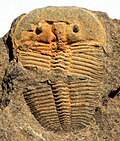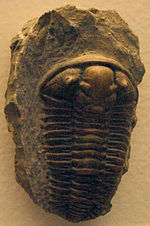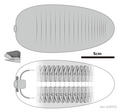The hypostome is the hard mouthpart of trilobites found on the ventral side of the cephalon (head). The hypostome can be classified into three types based...
5 KB (505 words) - 04:15, 23 November 2023
exit for the molting trilobite. It is absent in some trilobites like Lachnostoma. The hypostome is the hard mouthpart of the trilobite found on the ventral...
111 KB (11,936 words) - 12:16, 1 October 2024
up hypostome in Wiktionary, the free dictionary. In zoology, the hypostome can refer to structures in distinct animal groups: Hypostome (trilobite), the...
422 bytes (92 words) - 10:33, 25 July 2024
Cephalon (arthropod head) (redirect from Cephalon (trilobite))
occasionally the hypostome, a small rigid plate comparable to the ventral plate in other arthropods. A toothless mouth and stomach sat upon the hypostome with the...
7 KB (648 words) - 06:24, 14 January 2024
trilobites and their close relatives. The group is united by several morphological characters, including reduced or absent lateral eyes, a hypostome with...
10 KB (890 words) - 10:11, 18 October 2024
Proetida (category Trilobite orders)
Proetida is an order of trilobite that lived from the Ordovician to the Permian. It was the last surviving order of trilobite, dying out in the Permian-Triassic...
18 KB (1,187 words) - 17:12, 15 May 2024
Calymene blumenbachii (category Silurian trilobites of Europe)
Desmarest (1817), sometimes erroneously spelled blumenbachi, is a species of trilobite discovered in the limestone quarries of the Wren's Nest in Dudley, England...
4 KB (335 words) - 17:13, 12 March 2024
Terataspis (category Devonian trilobites of North America)
line with the eyes. The hypostome is almost flat and kidney-shaped and has a poorly defined central body. "Largest Trilobites". Sam M. Gon III. 2005-08-17...
2 KB (207 words) - 04:58, 11 November 2021
Librostoma (category Trilobites)
Librostoma is a subclass of trilobites defined by having a natant hypostome, which is a hypostome (mineralized trilobite mouthpart) that is free from the...
11 KB (974 words) - 05:04, 11 November 2024
Eldredgeops rana (category Devonian trilobites of North America)
Eldredgeops rana (formerly Phacops rana) is a species of trilobite from the middle Devonian period. Their fossils are found chiefly in the northeastern...
5 KB (439 words) - 15:01, 15 September 2024
Eodiscina (category Cambrian trilobites)
Eodiscina is trilobite suborder. The Eodiscina first developed near the end of the Lower Cambrian period (late Atdabanian) and became extinct at the end...
9 KB (971 words) - 12:40, 6 February 2024
not illustrated until 1847, when they were interpreted as the hypostome of the trilobite Prionocheilus. Antonin Fritsch was the first to formally describe...
7 KB (666 words) - 15:42, 15 May 2024
Phacopida (category Trilobite orders)
Phacopida ("lens-face") is an order of trilobites that lived from the Late Cambrian to the Late Devonian. It is made up of a morphologically diverse assemblage...
5 KB (447 words) - 06:01, 23 November 2023
Dalmanites (category Ordovician trilobites)
Dalmanites is a genus of trilobite in the order Phacopida. They lived from the Late Ordovician to Middle Devonian. The trilobites of this genus have slightly...
9 KB (877 words) - 21:33, 3 July 2024
Emucarididae (category Trilobite families)
Emucarididae is an extinct family of soft-shelled trilobite-like arthropods (nektaspids) from the Lower Cambrian of South Australia and South China. It...
3 KB (338 words) - 11:37, 4 April 2024
Trimerus is an extinct genus of trilobite in the family Homalonotidae. Trimerus is one of North America's largest trilobites, reaching over 20 cm (7.9 in)...
6 KB (568 words) - 06:28, 13 September 2024
Calymene celebra is a Silurian species of trilobites of the order Phacopida and also the state fossil of Wisconsin. It is found in Illinois, Indiana, and...
972 bytes (41 words) - 15:59, 13 March 2024
Saperion is an extinct genus of trilobite-like arthropod. It lived during the late Atdabanian stage, which lasted from 521 to 514 million years ago during...
3 KB (286 words) - 11:32, 3 April 2024
Redlichiida (category Trilobite orders)
is an order of trilobites, a group of extinct marine arthropods. Species assigned to the order Redlichiida are among the first trilobites to appear in the...
6 KB (706 words) - 15:28, 13 December 2023
Olenoides (category Cambrian trilobites)
anterior pair of appendages in trilobites. In O. serratus, these are attached about halfway the immediately adjacent to the hypostome, and appear from the dorsal...
8 KB (766 words) - 04:30, 31 May 2024
Hypodicranotus (category Ordovician trilobites of North America)
Hypodicranotus striatulus is an extinct, pelagic trilobite in the order Asaphida, of the family Remopleuridae. Its fossils are found in Middle Ordovician-aged...
2 KB (66 words) - 11:56, 2 October 2024
Flexicalymene (category Ordovician trilobites)
Flexicalymene Shirley, 1936. is a genus of trilobites belonging to the order Phacopida, suborder Calymenina and Family Calymenidae. Flexicalymene specimens...
8 KB (849 words) - 18:38, 25 February 2024
away from the trilobites, although he later described a second species of Cyclus which was later recognised as the hypostome of a trilobite. Cycloids were...
18 KB (1,866 words) - 13:04, 12 April 2024
Aulacopleura (category Ordovician trilobites)
Aulacopleura is a genus of proetid trilobite that lived from the Middle Ordovician to the Middle Devonian. Some authors may classify this group as subgenus...
9 KB (644 words) - 05:31, 23 November 2023
[ˌvɪvəzˈæspɪs]) (meaning "Veevers' shield") is an extinct genus of bathyurid trilobite from the Nambeet Formation in Western Australia. The type species is M...
2 KB (179 words) - 11:07, 18 June 2024
Colpocoryphe (category Ordovician trilobites)
Colpocoryphe is a genus of trilobites in the family Calymenidae. Convex Cephalon Trapezoidal glabellae, frequently distinctly furrowed and surelevated...
2 KB (166 words) - 05:30, 12 November 2023
Harpetida (category Trilobite orders)
first harpetid trilobites appear in the Upper Cambrian, and the last species die out at the end of the Devonian period. Harpetid trilobites are characterized...
4 KB (326 words) - 05:03, 27 July 2024
Bojoscutellum (category Devonian trilobites)
uralicum † Maksimova, 1979 Schematic Trilobite Bojoscutellum paliferum (Beyrich, 1845). A) cephalon B) hypostome C) pygidium D) width of pygidium Biolib...
2 KB (137 words) - 19:10, 18 April 2022
Odontochile (category Devonian trilobites of Africa)
Odontochile is a genus of trilobites in the order Phacopida, family Dalmanitidae. These trilobites were fast-moving low-level epifauna and detritivore...
7 KB (653 words) - 15:56, 30 July 2024
Metacalymene (category Silurian trilobites)
Metacalymene is a genus of trilobites in the order Phacopida, family Calymenidae. This genus is considered monotypic, containing only the type species:...
2 KB (93 words) - 22:24, 9 April 2023



























